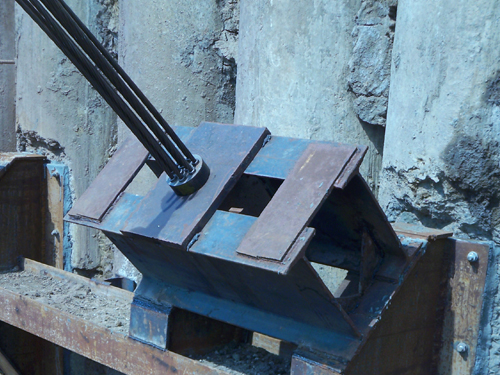Reliable Rock Anchors for Secure and Secure Structures
In the world of civil design, the function of dependable rock supports can not be overemphasized, as they are pivotal in developing safe and stable foundations throughout a variety of applications. Recognizing the different types of rock supports, their certain applications, and the complexities of installment and maintenance is necessary for optimizing their performance.
Kinds Of Rock Anchors

Passive supports count on the weight of the structure and the bordering dirt or rock to provide resistance. Active anchors, on the other hand, entail the application of stress through a high-strength cable television or rod, producing a pre-stressed problem in the anchor - Williams Anchors.
Grouted anchors are an additional substantial category, where a steel bar or cord is inserted into a drilled hole, complied with by a cementitious cement. As soon as healed, the cement bonds with the bordering rock, developing a durable anchoring system. Each kind of rock support supplies distinctive benefits based upon the details geological problems and architectural needs, consequently playing an important role in the overall integrity and longevity of constructed centers.
Applications in Construction
Rock anchors play a crucial duty in numerous building applications, offering important assistance and security in diverse settings. These ingenious services are made use of in tasks ranging from large-scale framework advancements to smaller household frameworks. One of the key applications of rock anchors remains in the stabilization of slopes and keeping wall surfaces, where they assist protect against soil disintegration and maintain architectural stability.
In addition, rock anchors contribute in safeguarding foundations for bridges, passages, and high-rise structures, ensuring they can hold up against lateral pressures such as wind and seismic activity. Their convenience permits setup in tough geological conditions, making them ideal for tasks in mountainous or rocky surfaces.

Secret Selection Requirements
Selecting the ideal rock anchor for a specific application needs mindful consideration of numerous key requirements. Most importantly, the geological problems of the website must be extensively evaluated. Comprehending rock kind, strength, and stability is necessary to make certain that the anchor will execute effectively under tons problems.

Another crucial factor is the rust resistance of the support products. In environments subjected to moisture or chemicals, utilizing corrosion-resistant products will certainly prolong the life expectancy of the supports and keep architectural integrity in time.
Furthermore, the anchor's installment method must line up with the task's requirements and constraints. Relieve of setup, in addition to the possible influence on bordering structures, should be thought about.
Setup Methods
Reliable installment strategies are important for the successful efficiency of rock anchors. Appropriate installation makes sure that the supports accomplish the preferred load-bearing capability and stability within the geological conditions. The very first step in the setup process includes site assessment, where geological surveys figure out the rock kind, condition, and any type of potential challenges.
Once the website is reviewed, the ideal click to read more exploration method must be picked-- alternatives consist of rotary drilling, ruby exploration, or percussion exploration. The option depends upon rock firmness and ecological considerations. Accurate drilling deepness and angle are crucial to make sure that the anchors align with architectural demands and load circulation.
After exploration, the following stage entails cleaning up the borehole to eliminate particles, which can jeopardize bond strength. Following this, the support is put, and if needed, a grout or material click here for info is injected to boost bond. The curing time of these products have to be stuck to, making certain that the supports achieve complete stamina prior to any type of load is used.
Maintenance and Assessment
Appropriate upkeep and evaluation of rock supports are necessary to ensure their lasting performance and integrity (Williams Anchors). Regular analyses help recognize any type of possible problems, such as deterioration, displacement, or architectural exhaustion that could endanger the integrity of the anchoring system
Routine examinations ought to be conducted at specified intervals, thinking about environmental aspects and the particular application of the rock supports. Visual assessments need to concentrate on the subjected sections of the anchors, looking for indications of corrosion, splits, or various other abnormalities. Additionally, it is important to review the surrounding geological conditions to discover any kind of changes in soil or rock that might impact anchor performance.
In many cases, advanced methods such as lots testing or non-destructive testing might be required to identify the anchors' load-bearing capacity and overall health. Correct documents of assessment findings, maintenance activities, and any repairs or replacements executed is vital for ongoing evaluation and compliance with industry standards.
Conclusion
Finally, trustworthy i thought about this rock supports play a crucial role in ensuring secure and stable structures throughout different building applications. By successfully transferring tons and improving stability against side pressures, these anchors contribute significantly to the long life and honesty of structures such as bridges, tunnels, and retaining wall surfaces. Strategic option, installment, and maintenance of rock anchors are essential for maximizing performance and protecting public safety, inevitably highlighting their importance in modern-day design practices.